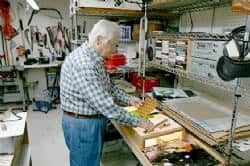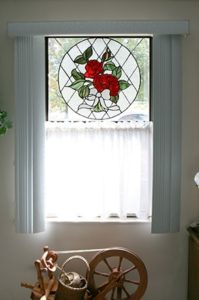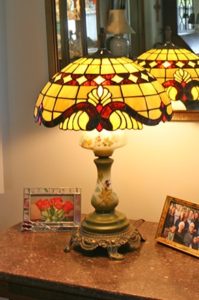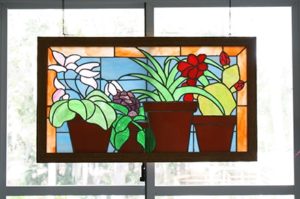
Pliers, cutters, grinders, soldering irons, lead, copper, and … glass — these are the tools of a stained glass artist. A touch of engineering, a dash of imagination and skilled hands come together to produce works of art that can only be truly appreciated in the light. Just like painting and sculpting, anyone can pick up the tools and produce a product. But it takes an artist to produce something beautiful. Harold Garner is an artist.
Harold held an interest in stained glass for a long time before he had the chance to study the craft. He was captured by the attractiveness of pieces he’d seen, he says. He had the chance to admire some works in Europe and was impressed by the ornate windows in many of the cathedrals. He more than appreciated the beauty; he was interested in the process — how it was done.
 It wasn’t until after he moved to Advent Christian Village in 2001 that Harold had a chance to follow a dream he had been postponing — the dream of becoming a stained glass artist. Harold and his wife met Bob and Barbara Hoffman and the foursome developed a close friendship. It just so happened that Bob was a stained glass artist. When Bob found out that Harold had an interest in the craft, he volunteered to teach Harold.
It wasn’t until after he moved to Advent Christian Village in 2001 that Harold had a chance to follow a dream he had been postponing — the dream of becoming a stained glass artist. Harold and his wife met Bob and Barbara Hoffman and the foursome developed a close friendship. It just so happened that Bob was a stained glass artist. When Bob found out that Harold had an interest in the craft, he volunteered to teach Harold.
Under Bob’s tutelage, and through some online training, Harold developed the skills necessary to craft beautiful stained glass. He has crafted many flat pieces, designed to hang in windows, and he has also made lamps and other three-dimensional projects. He explains that working with stained glass, like many other art forms, lends itself to “learning as you go.” The more you do it, the better you get. “Once you learn the basics,” says Harold, “you develop your own style.”
So, what are the steps for assembling a stained glass project? Harold explains the basics:
 Make a copy of your pattern. You’ll need one pattern to cut into the individual pieces and one to leave whole.
Make a copy of your pattern. You’ll need one pattern to cut into the individual pieces and one to leave whole.Several of Harold’s stained glass masterpieces will be on display in the Phillips Center gallery at Advent Christian Village for December and January. Those in the area are encouraged to stop by to admire these unique pieces of art.
 Harold Garner wanted to learn how to work with stained glass years before he learned how. This plant artwork was Harold’s first step toward becoming a stained glass artist.
Harold Garner wanted to learn how to work with stained glass years before he learned how. This plant artwork was Harold’s first step toward becoming a stained glass artist.